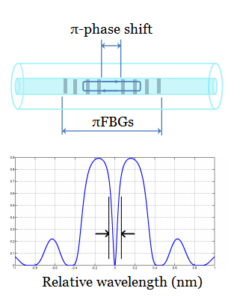 Nowadays, the special type of FBGs whose reflection spectrum has a notch arise from a π-phase discontinuity in the center of the grating (called π-phase-shifted FBGs) attracts ground interests among researchers. Because of their highly sensitive ultrasonic detection, πFBG may provide a solution to the sensitivity problems of the FBG. By introducing a π- phase shift into a refractive index modulation of the fiber Bragg grating during its fabrication, the spectral transmission has a narrow bandpass resonance appearing within the middle of the reflection lobe of the FBG. Such an element allows reaching a very narrow transmission band of few picometers.
Nowadays, the special type of FBGs whose reflection spectrum has a notch arise from a π-phase discontinuity in the center of the grating (called π-phase-shifted FBGs) attracts ground interests among researchers. Because of their highly sensitive ultrasonic detection, πFBG may provide a solution to the sensitivity problems of the FBG. By introducing a π- phase shift into a refractive index modulation of the fiber Bragg grating during its fabrication, the spectral transmission has a narrow bandpass resonance appearing within the middle of the reflection lobe of the FBG. Such an element allows reaching a very narrow transmission band of few picometers.
Fabrication of π-phase-shifted FBGs is achieved by splitting the standard FBG into two identical sub-FBGs with a half-period phase difference between them. The two sub FBGs create an interfere with each other and generate an ultra-narrow transmission window at the center of the FBG spectrum.
Due to the phase discontinuity, a πFBG can be conceptually described as a Fabry–Perot cavity formed by two FBG mirrors. When the two FBGs are highly reflective, the quality factor of the Fabry–Perot cavity is increased, leading to an extremely narrow spectral notch for highly sensitive ultrasonic detection.
Using special structures, even multiple transmission bands are possible.
The primary method used for the fabrication of π-Phase-shifted fiber Bragg grating is based on the UV laser and phase mask method. The occurrence of two peaks/dips is attributed to the refractive index modulations along with the fiber core, with the periodicity of the π-phase mask that has been observed previously in images of gratings that cause destructive interference in a reflected wave at the Bragg condition owing to the phase difference between the grating phases. Thus, the standard phase mask technique produced an alternative type of pi-phase-shifted grating at twice the design Bragg wavelength.
The phase-shifted gratings have found application in distributed feedback lasers, wavelength division multiplexing, athermal setup, or temperature stabilization, as well as to a tuning setup. Also, the π-phase-shifted FBG can be used in highly accurate wavelength references, ASE filtering, spectroscopy, and optical CDMA.

